For a more detailed look at each species of counterpoint refer to the related articles below. This article is intended to be a reference and summary of the main “rules” of counterpoint.
In general there are five elements to be aware of and control when writing traditional counterpoint: 1) lines move predominately by stepwise motion, 2) horizontal and vertical intervals between the pitches, 3) conventional penultimate and ending measures, 4) rhythmic values, and 5) intervallic repetitions.
Inside each of those five elements are many pieces to consider. If you learn how to control those five counterpoint elements, you are on your way to writing solid counterpoint.
Related Articles
- What is a cantus firmus?
- 1st Species Counterpoint
- 2nd Species Counterpoint
- 3rd Species Counterpoint
- 4th Species Counterpoint
Rules for writing your own cantus firmus
Something to keep in mind when working on any aspect of counterpoint is that this is music that originated from singing and was codified with the voice in mind. This means that certain rules were born because counterpoint began as vocal music rather than instrumental.
- Avoid exceeding the range of an octave.
- Avoid outlining a tritone, minor 7th, or major 7th.
- Avoid having to much motion going up or down.
- A good rule of thumb is to not have more than four notes moving in the same direction.
- Do not leap to a tritone, minor 7th, major 7th, or any interval greater than an octave.
- Should have only one note that is the highest pitch (do not repeat the highest pitch). This is the climax.
- Should move predominately by stepwise motion.
- Avoid more than two leaps in a row.
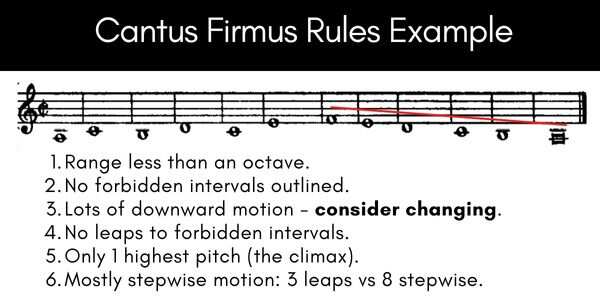
1st Species Counterpoint Rules
1st species takes some principle rules of writing a cantus firmus and extends them. The primary difference is that you now have vertical intervals to worry about. In order to follow along you must know what intervals are considered consonant and which ones are dissonant.
Consonances and dissonances in 1st species counterpoint
| Perfect Consonances | Imperfect Consonances | Dissonances |
| unison (P1) | minor 3rd (m3) | minor 2nd (m2) |
| perfect 5th (P5) | major 3rd (M3) | major 2nd (M2) |
| octave (P8) | minor 6th (m6) | perfect 4th (p4) |
| major 6th (M6) | tritone (TT), augmented 4th (A4), diminished 5th (d5) | |
| minor 10th (m10) | minor 7th (m7) | |
| major 10th (M10) | major 7th (M7) | |
| minor 9th (m9) | ||
| major 9th (M9) | ||
The three horizontal motions
Contrary motion is where the voices move it opposite directions. This is the type of motion you should use the most.
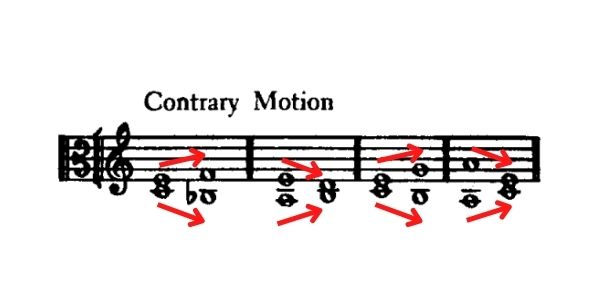
Direct motion is where the voices move by the same interval in the same direction.
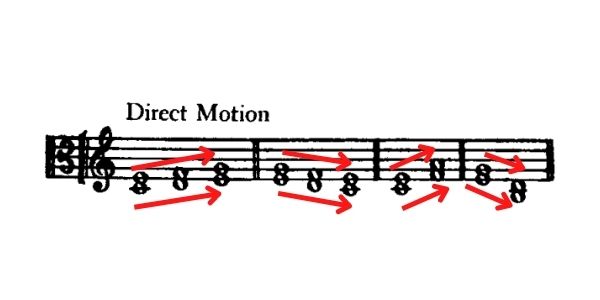
Oblique motion is where one voice stays the same and the other moves.
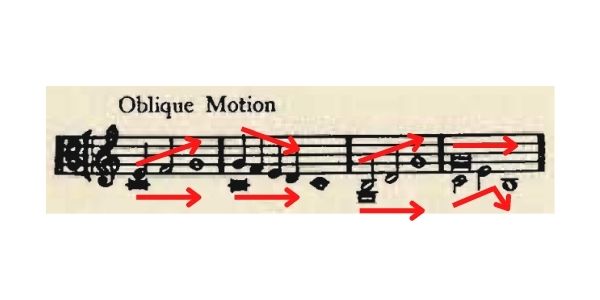
1st species rules
- Only use consonant intervals but strive to use more imperfect intervals than perfect.
- Strive to use more contrary motion than direct or oblique.
- perfect intervals can move to another perfect by contrary or oblique (not direct)
- perfect intervals can move to imperfect by any motion.
- Imperfect intervals can move to perfect by contrary or oblique (not direct)
- Imperfect intervals can move to imperfect by any motion.
- Do not let the interval between the voices exceed a major 10th.
- Try to limit voice crossings.
- Do not leap by a major 6th or dissonant intervals.
- Do not leap into an octave or unison even in contrary motion.
- Do not leap by an interval greater than an octave.
- Do not outline a tritone.
- Avoid repetitions.
1st Species Counterpoint Example

2nd Species Counterpoint Rules
From now on, I’ll be referring to the intervals and motion that was introduced in 1st species. The biggest changes are the use of two notes in the counterpoint for every note in the cantus firmus and the inclusion of dissonant intervals.
- The downbeat is always consonant.
- The upbeat (the second half of the measure) may be consonant.
- If the upbeat is dissonant, the notes before and after must be approached and left by stepwise motion. This will result in either neighbor tones or passing tones. See example below.
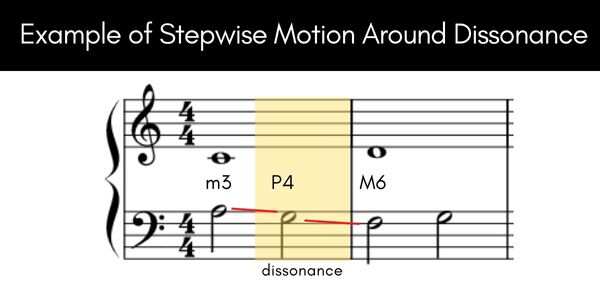
- If the weak beat (upbeat) moves by skip, the interval must be consonant.
- If the cantus firmus is in the lower voice, then the final two measures must have the following interval sequence: P5 — M6 — P8.
- If the cantus firmus is in the upper voice, then the final two measures must have the following interval sequence: P5 — m3 — P1.
- Do not write a series of measures where the downbeats are P5, P8, or P1.
- Don’t separate the voices by more than a 10th.
- Be careful with voice crossings (allowed but don’t do it too often).
- Prefer contrary motion over direct or oblique.
- No dissonant leaps.
- No leaps larger than an octave.
2nd species counterpoint example
There are always little issues you can disagree about when it comes to evaluating an exercise, but I like to remind anyone working towards learning counterpoint that it is just an exercise. The goal is to learn. So, correct the big mistakes, but more importantly understand the deeper reasons the rules exist in the first place. Remember that the rules came after the music, not the other way around!

3rd Species Counterpoint Rules
The species of counterpoint is now four notes in the counterpoint against one note in the cantus firmus. Most of the same rules from the previous species of counterpoint should be observed. The full article is here: 3rd Species Counterpoint.
- Start with a consonance.
- If five quarter notes are going up or going down the following rules apply:
- The 1st note must be consonant.
- The 2nd note can be dissonant or consonant.
- The 3rd note must be consonant unless all the other beats in the 5-note series are consonant.
- The 4th note can be dissonant if the 5th note is consonant.
- You can leap away from a dissonance if you then resolve it in the opposite direction by step. This is called “cambiata”.

- The next to last measure:
- If the cantus firmus is in the lower part, then the 2nd to last interval must be a major 6th that then moves by contrary motion to the octave.
- If the cantus firmus is in the upper part, then the 2nd to last interval must be a minor 3rd that resolves to a unison (can also be a minor 10th to an octave).
- It’s suggested to continue to use more contrary motion.
- It’s suggested to try not to write “too many” notes going in the same direction. How many is too many? Fux wrote up to nine notes going in the same direction, but use your ear.
4th Species Counterpoint Rules
This species changes things up rhythmically by tying half notes over the bar line. For the full article go here: 4th Species Counterpoint.
- The first measure of the counterpoint begins with a half rest.
- The upbeat (2nd half of the measure) must be consonant.
- The downbeat (1st half of the measure) can be consonant or dissonant.
- Dissonant intervals are resolved by moving down by stepwise motion to a consonant interval.
- When a ligature (tied note) is not possible, you can write a couple of half notes to get out of the situation.
- Be careful to avoid repetitions.
- The 2nd to last measure:
- If the cantus firmus is in the lower voice, you should have a 7th resolve to a 6th that then moves to the final interval of an octave.
- If the cantus firmus is in the upper voice, you should have a 2nd resolve to a 3rd that then moves to the final interval of a unison.

5th Species Counterpoint Rules
This species can also be called “florid counterpoint” because you are free to use a combination of any of the previous species. At this point you are getting a lot closer to actual composition. In this species Fux says, you are looking for melodic lines with liveliness of movement, and beauty and variety of form.
There are no specific rules to this counterpoint that are different than the rules already explained in the previous species. This is simply where you put them all together! Something to keep in mind though is that the counterpoint should always be viewed through the lens of a vocal melody – it should be singable.


Leave a Reply